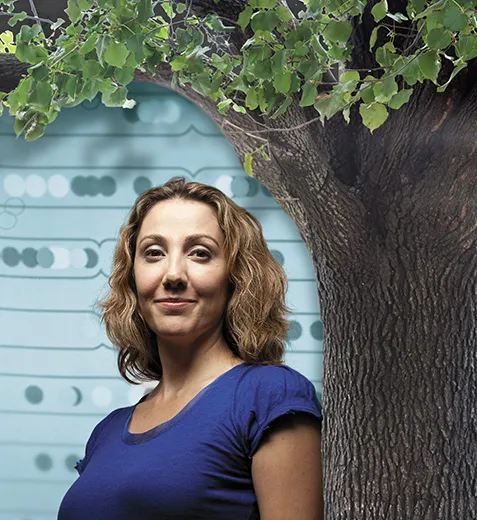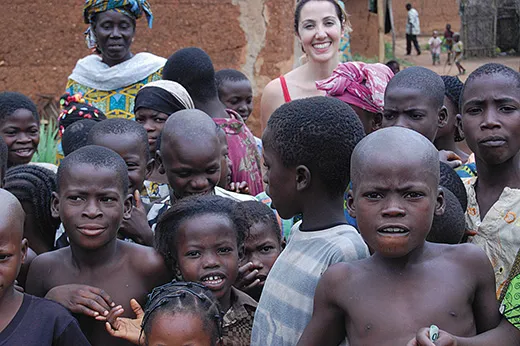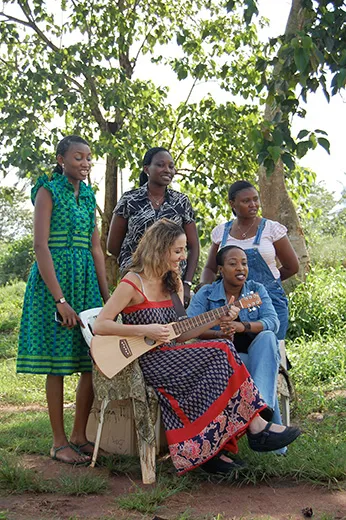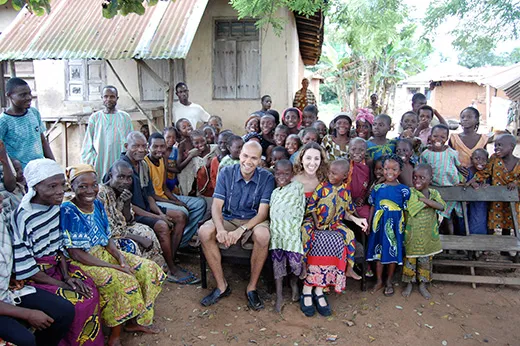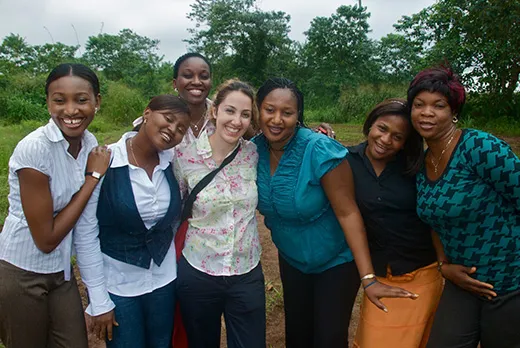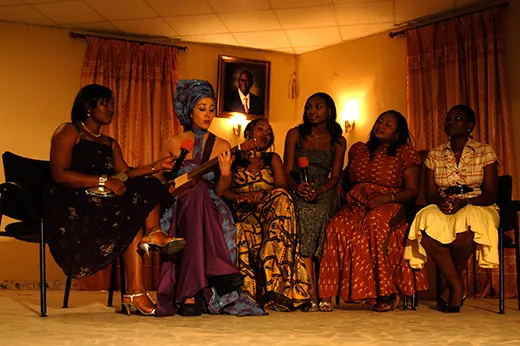Pardis Sabeti, the Rollerblading Rock Star Scientist of Harvard
The recipient of the Smithsonian American Ingenuity Award for natural sciences blazed a new view of how to treat infectious diseases via genetics
:focal(228x120:229x121)/https://tf-cmsv2-smithsonianmag-media.s3.amazonaws.com/filer/Ingenuity-Awards-Pardis-Sabeti-631.jpg)
Pardis Sabeti pulls a BMW SUV into the breezeway at Harvard’s Northwest Laboratory, an airy, minimalist structure of smooth concrete, tropical hardwood, and lots and lots of glass. The 36-year-old hyperkinetic physician and geneticist renowned for her computational approach to studying evolution and public health directs a 22-member laboratory that occupies prestigious top-floor space in this citadel of science. On this Sunday afternoon in October, she is meeting two of her graduate students to work on, of all things, a holiday greeting card. (The tradition began in 2008 when she bought everyone cheesy holiday sweaters from Kmart for a group photo; last year’s card featured a full-blown re-enactment of Raphael’s famous Vatican fresco The School of Athens, depicting the accumulation of knowledge through reason.) Daniel Park, 33, is already in the passenger seat of Sabeti’s car when Dustin Griesemer, a 24-year-old MD-PhD candidate, climbs into the back. Sabeti, wearing modishly rectangular eyeglasses and brown knee-high boots, starts the five-mile drive to Sky Zone, an indoor trampoline park.
Twenty minutes later, Sabeti, Park and Griesemer are snaking between packs of grade-schoolers to check out a pit called the Foam Zone. They sit down at a metal table near the snack bar and Griesemer explains why this year’s card should play off the viral music video “Gangnam Style.” Sabeti takes out her phone and watches on YouTube as an impeccably dressed South Korean rapper named Psy dances in horse stables, saunas, buses, motorboats and subways. The group is in agreement: A “Gangnam Style” homage will be impressive even if lab members aren’t hurtling through the air. The trampoline park will have to wait for another time.
With that settled, they head back to Harvard Square, and the conversation in the car segues to music, as it often does with Sabeti. Besides being an award-winning scientist, she’s the lead singer and bass player in the indie rock band Thousand Days, which has released four albums. “I have no innate sense of flux or flow or spatial cadence,” she says, explaining why the melodies in Thousand Days songs “go all over the place.” (Still, the band, which can sound like a spikier, more energetic version of 10,000 Maniacs, received an honorable mention in a Billboard World Song Competition.) “I have no sense of structure.”
What she unquestionably does have is a fierce determination to succeed. Her single-mindedness has led to a groundbreaking tool to determine whether a specific variation of a given gene is widespread in a population as a result of having been favored by natural selection. And her recent work to understand the genetic factors that influence individual human responses to diseases like malaria, as well as her genetic analyses of pathogens to pinpoint potential weaknesses, could potentially lead to new approaches to treating, and perhaps eradicating, deadly scourges. Beyond that, Sabeti says she wants to show the world that the best way to produce top-flight scientific work is to nurture researchers’ humanity and empathy—and have fun.
Eric Lander, director of the Broad Institute, a genomics research center affiliated with MIT and Harvard, has known Sabeti since the late 1990s, when she was an undergraduate advisee at MIT. “She had this boundless optimism that she could make [MIT] a better place,” he says. And so, along with being class president, playing varsity tennis, serving as a teaching assistant and publishing original research, Sabeti started MIT’s Freshman Leadership Program. The five-day curriculum—focusing on “inclusivity, empowerment, value defining and leadership skill building”—is still going strong.
“She was able to create this just through sheer force of will,” Lander says. “She has this force of will and a caring about making the world a better place, really fixing the world.”
***
Pardis Sabeti was born in Tehran, Iran, in 1975, where her father, Parviz, was a high-ranking official in the shah’s government. Two years later, on the cusp of the Iranian revolution, the Sabeti family fled to the United States, eventually settling in Florida. “My father took one of the toughest jobs in the government because he cared about his nation more than himself,” Pardis says. “His courage and conviction have always driven me to want to make a difference.”
In the early 1980s, Pardis’ mother, Nancy, bought some old textbooks, a chalkboard and a couple of school chairs and set up a makeshift summer school in the family’s home for Pardis and her sister, Parisa, who is two years older. Parisa, assigned the role of teacher, put together lesson plans and gave out report cards; Pardis directed the “performing arts” and helped run phys ed. The wide-eyed, toothy Sabeti sisters undoubtedly made for a cute tableau, but the work they were doing was intense and focused. “She would teach me everything that she had learned the year before in school,” Pardis says. When September rolled around, Sabeti was almost two years ahead of her classmates.
It was during those years that Sabeti first discovered her love for mathematics. “My sister taught me addition and subtraction and multiplication and division,” she says, “so by the time I got to school, I knew it all, and when we’d do the times tables, I was just focused on doing it faster than anybody else. I already had the information, so it just got me to focus on excellence.”
That focus continued straight through high school—she was a National Merit Scholar and received an honorable mention on USA Today’s All-USA High School Academic Team—and at MIT, where she majored in biology and had a perfect 5.0 grade-point average. After graduating in 1997, she set off for Oxford, England, on a Rhodes scholarship, to pursue research on human genetic resistance to malaria.
***
At the time, the main way scientists studied natural selection in human beings was by developing theories to explain the presence of a specific version of a gene in a population. This method dated back to the 1940s, when the British geneticist and evolutionary biologist J.B.S. Haldane speculated that the reason red blood cell disorders, such as sickle cell anemia, were more common in tropical environments where malaria was endemic was that the gene causing those disorders also conferred some protection against malaria—the “malaria hypothesis.” Beginning in the 1980s, researchers began developing more sophisticated tests to identify “signatures” of natural selection, but these were blunt tools that had difficulty detecting evolutionary changes that had occurred in the past 10,000 years—precisely when many diseases that ravage humans arose.
Sabeti was convinced that there was a way to pinpoint when more recent changes in the human genome had occurred and that this knowledge could lead to breakthroughs in fighting disease. Specifically, she wanted to use the makeup of neighborhoods of genes (called haplotypes) to determine if a specific gene variation (called an allele) in a given neighborhood had recently come to prominence in a population because it conferred an evolutionary advantage. This should be possible, she thought, by using the never-ending process of genetic recombination—the breaking and rejoining of DNA strands—as a kind of clock to measure how long ago a given mutation had swept through a population. If a widespread mutation had appeared recently—for instance, the mutation that enabled adult human beings to digest the lactose in cow’s milk, a nutritional advantage for many people in Europe after cows became common there—fewer recombination events would have occurred since it was introduced. As a result, the mutated version of that allele should be on a stretch of DNA that was more or less identical for everyone in a population. If the mutation had appeared a longer time ago, recombination would dictate that the area around the mutated allele would have gone through more random recombination events and it would be on a stretch of DNA that was more varied across the population.
It was a radical approach: Instead of using existing tools to analyze new data, she was trying to develop new tools to use on available data. When she was at Oxford, “Everybody thought what I was trying to look for was dumb,” Sabeti says. “It seemed as if I was just going to go nowhere. I know everyone has a hard time at some point when they’re in graduate school, but I was on the higher end of the hard time early on in my PhD.”
Nevertheless, Sabeti returned to Boston to attend Harvard Medical School and kept at it, taking “a series of little steps,” she says. “I was just charting my path in my own weird ways.” Then, early one morning, she plugged a large data set related to the DC40L gene, which she’d already linked to malaria resistance, into an algorithm she’d developed and watched results showing it was associated with a common haplotype—indicating it had recently been selected for—come into focus on her computer screen.
“I was just sort of beside myself with excitement,” she says. “It’s a really exciting moment when you know something about the whole world that no one else does. I wanted to call somebody, but didn’t know anybody I felt comfortable calling at 3 a.m.”
***
There’d be plenty of people eager to talk to Sabeti before long. That October, she was the lead author on a paper published in Nature that laid out her discovery’s “profound implications for the study of human history and for medicine.” For the first time, researchers could look for evidence of positive selection by testing common haplotypes even if they didn’t have “prior knowledge of a specific variant or selective advantage.” By applying this approach to pathogens, there was the possibility of identifying how diseases had evolved to outwit the human immune response or develop drug resistance—knowledge that would open up new avenues to combating disease.
All of a sudden, the previously unknown 26-year-old was a superstar. David Hafler, a Yale neurologist and immunobiologist who has worked with Sabeti, compares her approach to that of a preternaturally gifted athlete, the hockey great Wayne Gretzky. “He was asked, ‘Why are you always where the action is?’ And he responded, ‘I don’t skate to where the puck is, I skate to where the puck is going to be.’ That’s the reason she’s able to make all of these fundamental contributions.”
By 2006, when Sabeti became just the third woman in the history of Harvard Medical School to graduate summa cum laude, she was working with Lander at the Broad Institute. Using the massive amounts of data being made available by next-generation genetic sequencing, Sabeti and her colleagues developed a tool to pore through the entire human genome (as opposed to just a handful of haplotypes) to locate gene variations that appeared to have been under recent selection pressure.
In a 2007 paper also published in Nature, they zeroed in on three clear examples in which genes involved in a common biological process underwent selection in the same population. The first gene pair, SLC24A5 and SLC45A2, played a role in skin pigmentation in Europeans. The second pair, EDAR and EDA2R, was involved in the development of hair follicles in Asians. And the third gene pair, LARGE and DMD, was related to susceptibility to infection by the Lassa virus in West Africa.
Sabeti’s background in malaria and interest in infectious diseases pushed her to focus on Lassa, an acute viral hemorrhagic fever first identified in the Nigerian town of Lassa in the late 1960s. The U.S. Centers for Disease Control and Prevention identifies Lassa virus as one of only a handful of Category A agents, which “pose a risk to national security” because they’re deadly, can be easily transmitted between humans and “might cause public panic or social disruption.” Like the Ebola virus, Lassa virus is often referred to as an emerging pathogen, because the documented human cases have occurred relatively recently.
As Sabeti would quickly discover, working with Lassa presented a unique set of challenges. “I realized that I had become interested in a [virus that has]...very few people working on it,” she says. “In order to do that I just had to figure out how to do it myself.”
By now an assistant professor at Harvard’s Center for Systems Biology, Sabeti spent some of her junior faculty startup funds as well as money from an $875,000, five-year science and engineering fellowship from the Packard Foundation setting up a collaboration with a medical facility in Nigeria, the Irrua Specialist Teaching Hospital.
Sabeti’s decision to conduct fieldwork on a dreaded pathogen in a dangerous country 5,000 miles away was a bold move, especially considering she was best known as a computational geneticist. “I had tremendous challenges,” she says. “Universities are not always thrilled about having someone actively working with a deadly virus.”
Yet Sabeti’s holistic approach led to unexpected results. The financial support she provided to the Irrua hospital enabled caregivers to diagnose more patients and to offer treatment with the powerful antiviral drug ribavirin. “As the hospital got more and more proficient...we got more and more patients from a larger area,” Sabeti says. Soon the researchers had collected blood samples from more than a thousand people, including many plagued by fevers of unknown origin, and “every person with a fever was trying to get to this hospital” for treatment, Sabeti recalls. Based on the analyses of blood samples, and her reading of the literature, she began to suspect that many more people had been exposed to both Lassa and Ebola than had been previously believed.
Those data form the backbone of a provocative, just-published paper in Science, “Emerging Disease or Emerging Diagnosis?” She and her co-authors speculate that Ebola and Lassa might not be emerging diseases at all, but instead represent the “emerging diagnosis of a disease that has long been common but overlooked” and had “interacted with humans for far longer than generally thought.”
If this hypothesis is correct, it will have an enormous impact in how medical experts think about, and develop treatments and interventions for, diseases such as Lassa and Ebola: In addition to caring for those sick enough to end up in the hospital, researchers can study why some people are relatively unaffected by the virus. If the LARGE gene mutation common in West Africa was selected for because it helped humans resist infection with Lassa virus, mimicking changes caused by the gene could pave the way for treatments, or perhaps even a Lassa vaccine.
Thousands of patients in Nigeria have already benefited from Sabeti’s work, says Christian Happi, director of the Infectious Diseases Laboratory at the hospital in Irrua. “That simple action—to go out into the field, in a rural setting in Nigeria, to go down there to provide diagnostics and help with treatment in this rural community, very far away, with no infrastructure—it’s incredible,” Happi says. “Apart from being dedicated, generous with her time, generous with her knowledge—generous with everything, really—she just really wants to be involved. That type of generosity is a quality that not many people have.”
***
One Saturday night this past September, Sabeti, her family and members of her lab gathered at Lander’s house in Cambridge to celebrate her recent marriage to John Rinn, an assistant professor of stem cell and regenerative biology at Harvard. (Lander had also gotten ordained by an online ministry so he could preside at the actual wedding a few weeks earlier.) Sabeti and Rinn, a specialist in RNA genetic material, met at the Broad, and their profiles seem to mirror each other: Sabeti’s a rock musician, Rinn’s an avid snowboarder who once thought about going pro; Mental Floss magazine named Sabeti one of “eight trailblazing scientists about to change your life” in 2007, Popular Science named Rinn one of the “ten young geniuses shaking up science today” in 2009; Sabeti’s initial approach to computational genomics was assumed to be a waste of time, as was Rinn’s early work on large intervening non-coding RNAs, or LINCs.
During the party, one of Sabeti’s students jumped into the middle of the room and started to dance to the Swedish pop star Robyn’s 2010 hit “Dancing on My Own.” A handful of other people jumped in, and then a few more. By the time “Starships” by the Trinidadian rapper Nicki Minaj and “Gangnam Style” had finished playing, it was clear that members of the Sabeti Lab had been meeting after-hours to rehearse. “It was awesome,” Sabeti said the next morning in a coffee shop in Boston’s Kenmore Square. “My mom joined in, Eric joined in—just incredible.”
It’s not surprising that people who work with Sabeti are so devoted to her. Dyann Wirth, the chair of the Department of Immunology and Infectious Diseases at the Harvard School of Public Health, says that Sabeti is “brilliant—one of the smartest people I know,” but it’s her dedication to the people she works with that makes her unique. “She’s inspirational,” Wirth says. “She sets the bar very high and at the same time treats people with tremendous respect. That’s very hard to do.”
So Sabeti’s legacy may be defined as much by shaping the careers of the people around her as by her world-class contributions to science. And that’d be just fine with her. “My kind of, like, life goal is to help train students to be good people as well as good scientists,” she says. “That would be my dream.”

